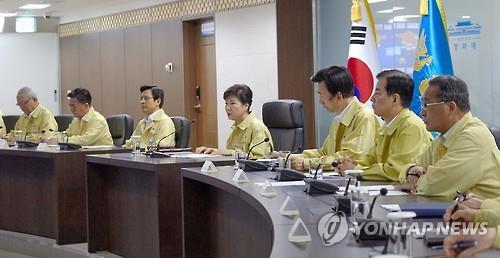The presidential office Cheong Wa Dae on Wednesday held an emergency standing committee session of the National Security Council to discuss North Korea's submarine-launched ballistic missile launch.
 |
Photo taken on Aug. 22, shows President Park Geun-hye (center) presiding over a National Security Council session at the presidential office Cheong Wa Dae in Seoul. (Yonhap) |
Seoul's Joint Chiefs of Staff said that the communist regime test-fired the SLMB near its eastern port city of Sinpo at around 5:30 a.m. The missile flew some 500 kilometers and fell into waters 80km inside Japan's air defense identification zone, the JCS said.
Wednesday's launch, the third since April, is seen as a success, whereas a series of past launches ended in failure or were only partially successful.
Analysts say the North's push for an underwater weapons system poses a grave security threat to South Korea and the United States, as an SLBM is hard to detect before it emerges from the water.
Along with the nuclear-capable bomber and intercontinental ballistic missile, the SLBM completes the strategic nuclear arsenal, which experts call the "nuclear triad."
Fears about SLBMs stem from the North's potential "second-strike capability" to launch a sudden nuclear retaliation if it faces a "first strike" from enemy forces.
Second-strike capability forms the basis of a condition referred to as "mutual assured destruction (MAD)" that is credited for maintaining the "long peace" between the US and Soviet Union during the Cold War. Under the condition, one dares not initiate nuclear warfare that would lead to mutual annihilation. (Yonhap)





![[Exclusive] Hyundai Mobis eyes closer ties with BYD](http://res.heraldm.com/phpwas/restmb_idxmake.php?idx=644&simg=/content/image/2024/11/25/20241125050044_0.jpg)
![[Herald Review] 'Gangnam B-Side' combines social realism with masterful suspense, performance](http://res.heraldm.com/phpwas/restmb_idxmake.php?idx=644&simg=/content/image/2024/11/25/20241125050072_0.jpg)

